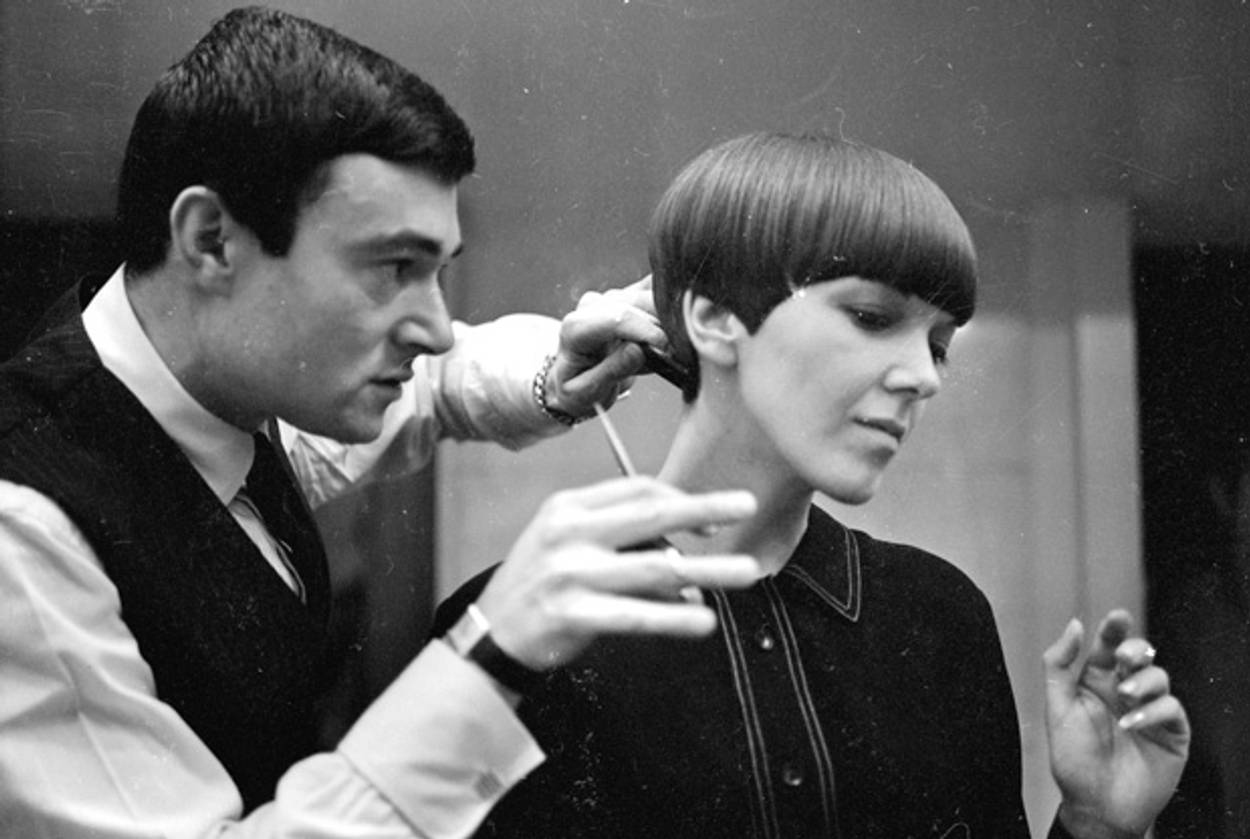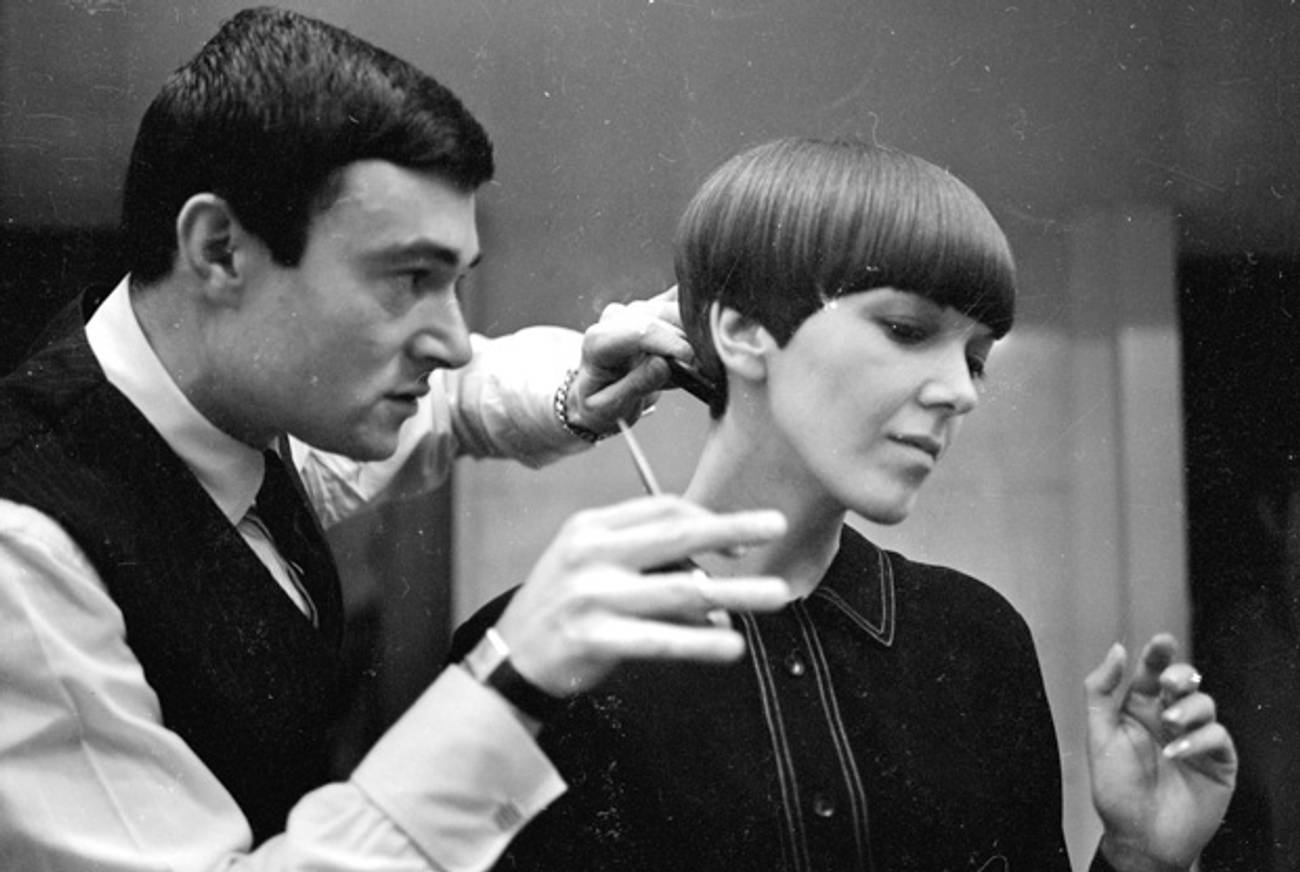Vidal Sassoon, Streetfighter
The famed hairdresser, who died Wednesday, fought against British fascists and then for Israel’s independence




Rabbi Israel Elia, head of the venerable Spanish and Portuguese Synagogue in London’s Maida Vale district, remembers the day when he met Vidal Sassoon, one of the congregation’s most celebrated sons. Elia had been quietly working in his office on a spring morning two years ago when an anxious colleague relayed the news that a film crew had gathered outside the building. The rabbi went to investigate.
“At the head of the crew, there was a smartly dressed man with delicate, graceful features,” Rabbi Elia recalled yesterday. “He walked over to me and introduced himself as Vidal Sassoon. He was making a film about his life and career.” Pointing to an annex at the side of the synagogue, Sassoon explained that the building had housed the orphanage where he spent his childhood.
“So, I took him inside,” Elia said. “He told me, ‘I want to show you where my dormitory was.’ We entered a room and he looked around. He was excited: ‘Yes, this was it, this was the dormitory.’ I looked at him and said, ‘Vidal, your dormitory is now my office.’ He threw his arms around me and hugged me, telling me about the kindness of our community, how his accomplishments would not have been possible without that generosity.”
Such were the inauspicious beginnings of a man who, through an international chain of hair salons and a bewildering array of grooming products, revolutionized women’s style in the decades that followed World War II. The son of a Turkish Jewish father and a Ukrainian Jewish mother, Sassoon was born in Shepherd’s Bush, West London, in 1928. Known to its residents as “The Bush,” it was a neighborhood with a tough reputation, home to large immigrant communities from Ireland, Poland, and other points east and west.
Sassoon was still in diapers when his father walked out on his mother, Betty. Destitute and unable to cope, Sassoon’s mother learned that there was an orphanage at the Spanish and Portuguese synagogue, approximately two miles away. One day in 1933, she turned up with the young Vidal in tow and placed him in the care of the oldest Jewish community in England.
Having been implanted in the orphanage, Sassoon joined the synagogue choir. During his visit with Rabbi Elia, Vidal went up to the elevated box where the choir still sits. “He started to recall one of his favorite tunes,” said Elia. “I figured out that it was Yimloch Adonai, one of the songs we sing on Shabbat. We sang it together.” (As a child growing up in the same synagogue, I remember being drafted into the same choir and grumbling about it. One of the adults admonished me, “Vidal Sassoon used to sing in this choir, so if it’s good enough for him, it’s good enough for you!”)
By his own account, Sassoon’s years at the orphanage were happy ones. (Sassoon, unlike his younger brother Ivor, was never bitter toward Betty, with whom he remained close.) But when the Luftwaffe began its nightly bombing raids on London, he was evacuated, along with thousands of other children from the city, to the countryside. Returning to London at the age of 14, he entered the hairdressing trade that was to make his reputation, starting out as an apprentice at a barber’s shop in the Whitechapel district of East London.
As he threw himself into his new vocation, Sassoon further cemented his attachment to the Jewish community. “He wasn’t religious, but he was extremely proud to be a Jew, and he was a dedicated Zionist,” Rabbi Elia said. In the immediate postwar years, London’s Jews faced a new threat from the remnants of British Union of Fascists, a Hitlerite party led by Sir Oswald Mosely, whose black-shirted followers had regularly clashed with Jewish immigrants in the East End during the 1930s.
Sassoon recalled England’s hostile political atmosphere earlier this year: “Anti-Semitism was absolutely rife,” he said in a podcast for the Holocaust Memorial Museum. “I mean, it was nothing for another kid to say to you, ‘Dirty Jew.’ And although England was a good place to be, especially with Churchill and the fight against the Nazis, there was always that sense of the Jews being second-class citizens.”
In 1947, the fascists again began menacing London, this time under the tutelage of Jeffrey Hamm, head of an organization of thugs calling themselves the “Association of British Ex-Servicemen.” For Sassoon, this was not a fate to be accepted lying down.
As a response to Hamm’s provocations, a gathering of young Jews known as the 43 Group—named for the number of people in the room at their founding—announced that the fight back had begun. Among them was the slender, if wiry, Sassoon. As Hamm’s followers gathered on street corners bellowing that “not enough Jews were burned at Belsen,” Sassoon and his comrades, armed with knives, coshes, and knuckledusters, set about breaking up fascist meetings. In another interview, Sassoon remembered turning up for work one morning with a black eye. “I just tripped on a hairpin,” he explained to the worried customer who had just settled into a barber’s chair for a haircut.
Encouraged by his ardently Zionist mother, Sassoon’s exploits with the 43 Group led him to a higher calling. In 1948, as the British Mandate was drawing to a close, Sassoon arrived in Palestine where he joined the Palmach in the fight for Israel’s independence. In the manner of the young men and women who had flocked to Spain in the previous decade to fight on the Republican side during the Civil War, Sassoon’s decision to participate in the Zionist struggle for independence, like that of the other volunteers who came from Europe and America, was rooted in a commitment to Jewish pride and honor.
“That was the best year of my life,” Sassoon later told a British newspaper. “When you think of 2,000 years of being put down and suddenly you are a nation rising, it was a wonderful feeling. There were only 600,000 people defending the country against five armies, so everyone had something to do.” Sassoon served in combat. “I wasn’t going over there to sit in an office,” he told the Jewish Chronicle. “I thought if we don’t fight for a piece of land and make it work, then the whole Holocaust thing was a terrible waste. But this way at least we got a country out of it.”
Shortly after Israel won its independence, Sassoon was back in England. Slowly but confidently, the former streetfighter and soldier turned himself into an international celebrity. His trademark hairstyle, the boyish, geometric bob-cut named for the actress Nancy Kwan, who first wore it, was especially popular with the skinny, waif-like stars of the day. But his most famous cut of all was a pixie crop for the actress Mia Farrow for her 1968 film Rosemary’s Baby.
Mingling with the A-list, Sassoon relocated to Los Angeles, embracing a lifestyle that doubtless would have furrowed the eyebrows of the elders at the Spanish and Portuguese synagogue. “In those days,” he matter-of-factly told an interviewer last year, “having sex was the same as having dinner.”
At the same time, Sassoon remained anchored in his Jewish identity, and wary of any threat to Jewish security. In 1982, he created the Vidal Sassoon International Center for the Study of Antisemitism at the Hebrew University in Jerusalem. “We had several heart to heart talks in recent years,” Professor Robert Wistrich, the center’s long-time head, told me. “He was shaken by the Shoah and by his experiences in postwar England. He was absolutely driven by the sense that one had to do something because anti-Semitism was always there beneath the surface. The way he saw it, anti-Semitism, the Shoah, was presented as a righteous act. It wasn’t an academic point of view, it was a moral one based on his own experience.”
Rabbi Elia concurred: “After we finished our tour of the synagogue and the orphanage, we sat in the kitchen for a meal prepared by my wife. He was passionate, asserting that Jewish people should always be on guard, ready to defend themselves.”
Elia interprets Sassoon’s dedication through the Judaic concept of hakarat hatov—acknowledging of the goodness of others. “It was something he carried with him from the orphanage onwards. It’s a very Jewish attribute.”
***
Like this article? Sign up for our Daily Digest to get Tablet Magazine’s new content in your inbox each morning.
Ben Cohen, a former BBC producer, is a writer based in New York who publishes frequently on Jewish and international affairs. His Twitter feed is @BenCohenOpinion.
Ben Cohen, a former BBC producer, is a writer based in New York who publishes frequently on Jewish and international affairs. His Twitter feed is @BenCohenOpinion.